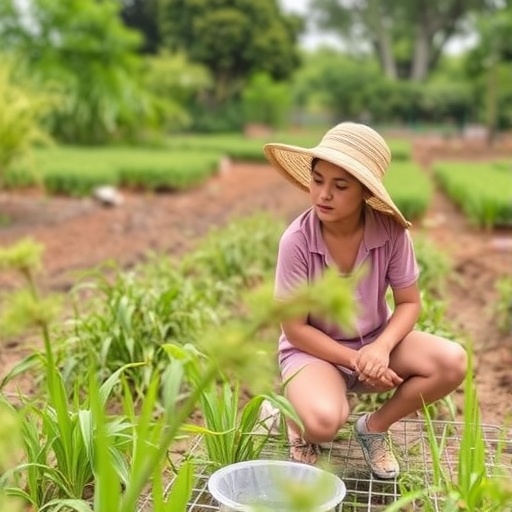A groundbreaking study from the University of California, San Diego, recently published in Nature Sustainability, delves into an often overlooked aspect of global agriculture: the very source of rainfall that nourishes crops. This research highlights the critical relationship between the origins of atmospheric moisture and the vulnerability of crops, revealing insights that could dramatically influence agricultural policy and practice amid increasing climate uncertainties.
At its core, the study investigates the journey of atmospheric moisture, tracing it back to either oceanic or terrestrial sources. The fundamental process begins with the sun’s heat, which evaporates water from various surfaces, including oceans, soils, lakes, and forests. This vapor ascends into the atmosphere before precipitating back to Earth as rain. Ocean-sourced moisture has the capacity to travel vast distances, dominated by global wind patterns, often forming large-scale weather phenomena such as atmospheric rivers and tropical storms. In stark contrast, land-sourced moisture, frequently referred to as recycled rainfall, is more localized, stemming predominantly from the evaporation of nearby vegetative and soil sources, ultimately nurturing local weather systems.
The pivotal finding of this research is that the proportion of rainfall derived from land as opposed to the ocean substantially affects a region’s drought risk and agricultural productivity. This balance is particularly crucial, as the study reveals that when over one-third of rainfall originates from land, croplands face heightened vulnerabilities to drought, potential soil moisture depletion, and declining crop yields. The variability in rainfall reliability, particularly linked to land-sourced moisture, emerges as a serious concern for farmers who depend on steady and consistent precipitation, especially during critical growth periods for their crops.
Yan Jiang, the study’s lead author and a postdoctoral scholar at UC San Diego, voiced the significant implications of these findings for policymakers and farmers. Understanding the origins of rainfall can provide new predictive tools to help mitigate the impacts of drought. Rather than solely focusing on precipitation amounts, which traditionally dominates drought assessments, it is equally essential to consider the origins of that rainfall. By shifting the focus to these critical sources, stakeholders can better anticipate drought conditions and cultivate more resilient farming strategies.
The research harnesses nearly two decades of satellite data, enabling Jiang and co-author Jennifer Burney from Stanford University to quantify how much of the world’s rainfall is linked to land evaporation. Their results underscore a worrying trend: as rain originates more frequently from land, regions such as the U.S. Midwest and tropical East Africa increasingly find themselves on the frontline of agricultural risk. The diminished reliability of local storm systems, often associated with land-derived rainfall, can trigger a feedback loop that exacerbates drought conditions, with alarming implications for food security and agricultural outputs.
The focus on the U.S. Midwest reveals a region grappling with escalating drought frequencies that threaten even its most productive agricultural lands. Jiang articulates how reliance on land-sourced moisture compounds the challenges farmers face, creating a perilous cycle where decreased soil moisture leads to reduced evaporation, further diminishing future rainfall. This cycle not only jeopardizes local agricultural integrity, but it also reverberates through global grain markets, showcasing the far-reaching consequences of climatic variations in this crucial farming region.
Contrastingly, the research identifies East Africa as a region at risk due to rapid agricultural expansion and deforestation. The destruction of rainforests impairs the area’s moisture sources, thereby jeopardizing the very rainfall patterns that support its agriculture. Jiang emphasizes the paradoxical dilemma facing farmers in this region: as they convert vital forest land into cropland to meet rising food demands, they simultaneously diminish the rainfall that is critical to sustaining those very crops. This interplay underscores the urgent need for a reassessment of land management strategies to safeguard both agricultural productivity and ecological health.
The findings also reiterate the importance of forested ecosystems as vital rainmakers. Jiang notes that upland forests actively contribute to atmospheric moisture through the processes of evaporation and transpiration, which in turn enhance local rainfall conditions essential for agriculture. The preservation of these natural ecosystems becomes a key focus for maintaining agricultural stability amidst climate change. Protecting forests is not merely a matter of biodiversity; it’s pivotal for ensuring sustainable agricultural practices and food security for future generations.
Additionally, this research advocates for efficient land and water management practices as vital components of a comprehensive strategy to enhance drought resilience. Jiang proposes that governments and agricultural stakeholders can leverage the new scientific framework established through this study. By mapping rainfall patterns and understanding the sources of moisture, they can identify strategic investment opportunities in irrigation infrastructure, soil water conservation, and forest conservation. Such proactive measures can fortify agricultural systems against the uncertainties brought about by climate change.
In conclusion, this research provides significant reflections on how the origins of rainfall shape agricultural vulnerability. By deepening our understanding of these dynamics, policymakers and farmers gain a powerful lens through which to view and adapt to the looming challenges posed by changing climate conditions. The study just scratches the surface of a complex distillation of nature and agriculture, urging the world to reconsider its relationship with both land and water resources.
As we contemplate the implications of these findings, it becomes increasingly clear that the future of agricultural resilience hinges not just on technological advancements, but also on our willingness to protect and understand the natural systems that sustain life itself.
Subject of Research: The relationship between moisture sources and global crop vulnerability to drought.
Article Title: Crop water origins and hydroclimate vulnerability of global croplands.
News Publication Date: 24-Oct-2025.
Web References: Nature Sustainability.
References: Not applicable.
Image Credits: Not applicable.
Keywords
Moisture sources, crop vulnerability, drought risk, atmospheric moisture, land and ocean, agricultural productivity, sustainability, U.S. Midwest, East Africa, forest ecosystems, irrigation management, climate change.




